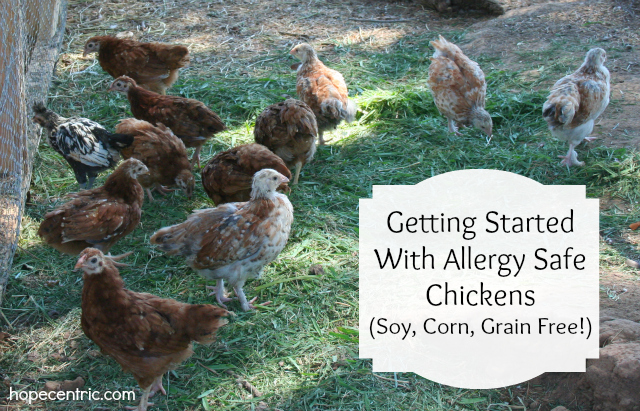
Did you miss the post about my daughter’s food allergies and the start of our grain free chickens? Check that out here: Our Grain Free Chickens
And if you are curious about allergens found in meat due to feed, check out this post:
A Hidden Cause for Meat Allergies
There are a ton of options for backyard chickens and small scale-poultry flocks. It’s pretty easy to successfully raise a few chickens, even on a suburban lot in a confined run. Modern chicken hybrids have been designed for just this situation, and do really well on a commercial feed that is high in grain.
But if you are looking to do something a little out of the norm, like raise a soy free or corn free or even grain free chicken, then the game changes and the information is zip to none.
I have absolutely no idea how many farmers I spoke to about raising chickens before we started our grain free adventure. I am certain that if I had kept count it would have been well into the dozens. In the beginning it was very informative, but after awhile it really just got obnoxious. Very few had information they could share on why they fed what they did. The focus was usually business – cheap feed and lots of eggs or meat. A few shared bits of information with me that ended up being jewels. I will be forever grateful to Harvey Ussery for his information, and for the help of a local chicken breeder who continues to be an awesome resource.
So let’s get down to business. What did I glean from these farmers, and what have I learned through personal experience?
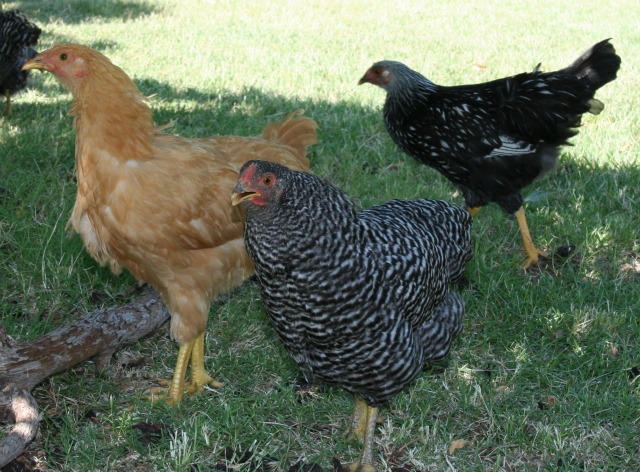
When raising special diet chickens, the most important choice is choosing your chicken breed.
It is possible to raise any type of chicken on a soy free, corn free, and/or grain free feed. But some are going to be built for it and do wonderfully, and others are going to cost a lot in supplements and additional work. The end result will not be the same with every hybrid or breed. cloud hosting info And some, like the Cornish Cross, may not survive long enough to be butchered.
While we were still living in a suburban community, I had a local farmer offer to raise meat chickens for us. I had heard several stories from farmers about not wasting our time with Cornish Cross if we were not going to be feeding them corn and soy. I shared that information with the farmer but he still ordered them. I can only guess because this was his first round of chickens and he was going with mainstream suggestions. We paid a LOT of money, and the result was far from great. Every update I got included sick chickens and vitamin supplements that were needed. The birds were just not growing. Finally around the time they should have been ready for butcher, I got a call and was told that several had just dropped dead. Many of the remaining couldn’t walk or were in distress, and he was taking them in for immediate processing. The call from the processing plant revealed several were pulled from the line for disease, and the remaining birds averaged 2-3 pounds. We called them our pigeons. I am not joking when I say it took at least 2 to make one pot of broth that was not entirely clear. An entire waste of money.
How do you avoid such a mess?
First, determine the purpose of your chickens.
Chickens are grouped for meat, eggs, or dual purpose. It’s pretty easy to narrow this down if you are looking for one or the other. If you are going for a dual purpose bird it gets a little trickier.
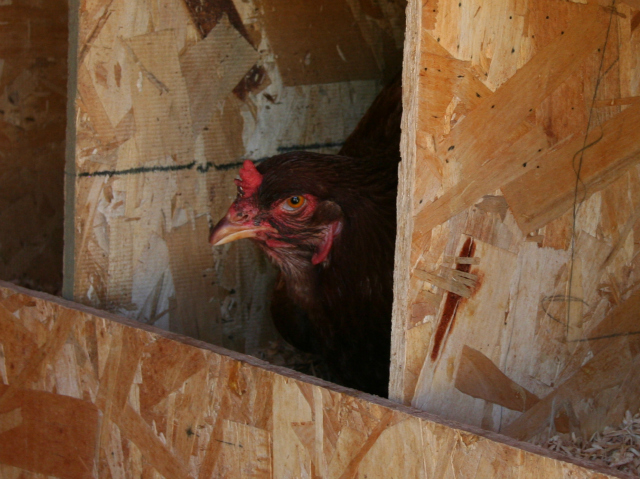
Those considered top egg laying birds will produce the most eggs, but these chickens are usually smaller in size. While you may be able to get a pot of broth from one, its not the best choice if you are wanting to raise meat. A meat bird will lay eggs (obviously), but should be butchered about the time they start to lay. Dual purpose chickens can be kept for eggs, or butchered for meat. These breeds lay less eggs than the top egg layers, but also grow to a good butchering size.
In summary, if you want eggs, choose a top egg laying chicken. If you want meat, choose a top meat breed. Why might you want dual purpose? If you are going to hatch your own or buy straight run chicks, you will get some roosters and some hens. This gives you the chance to butcher those roosters you don’t want instead of just trying to find a home for them. Also, some of the dual purpose breeds are amazing layers, and have great personalities for being around children. I wanted an egg layer that we could butcher after a couple of years when the laying began to taper off. An older chicken is not going to make good rotisserie, but it will certainly make a good soup!
Second, consider how much room your chickens will have, and what you plan to feed (or not feed) them.
These two things really must be examined together. If you are going to attempt to feed your chickens anything other than a mainstream, commercial, corn and soy included feed, then it will change the breed of chicken you need to be successful. For grain free chickens, Cornish Cross hens are out all together. They are bred to be fed and raised in a certain way, and grain free or on pasture is not one of them. They are used for commercial chicken operations for a reason. I have heard stories of backyard chicken owners being somewhat successful with them, but it always involves the ability to modify diet or supplement as needed to keep them from getting sick. They are majorly immune compromised, and are known for heart and lung issues.
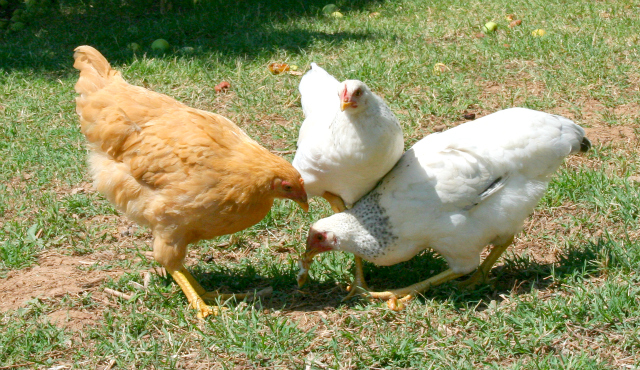
If you choose the right breed, your chickens will fill their bellies while foraging and you will only need to provide some supplemental feed and treats. Some breeds will not be as proficient at doing this, and they will need significant vitamin and food supplementation to stay healthy. That adds up really fast and begins to get rather obnoxious. No matter how confined your space is you can fix it all by feeding your chickens red worms, meal worms, or blowfly fly larvae. You can grow any of these at home. I couldn’t believe it when a farmer told me that they kept their hens fed by drilling holes in a metal bucket and then hanging the bucket full of decomposing carcass (like roadkill). The fly larvae would drop and the birds would fill their bellies! Gross, perhaps. But genius! And super cheap, too. I’m not sure this would go over well with most H.O.A.’s though, so you probably should reserve this for chickens on significant amounts of pasture.
Last, understand there are huge differences between hybrid chickens and heritage breeds.
There are also show birds, but for our purpose we will leave them out. If you are interested in raising a medal winning chicken, you can check the American Poultry Association for more information. My daughter wants to join 4-H and raise a show chicken this year. That should be an adventure!
A hybrid chicken is developed by crossing heritage breeds and/or other hybrids. They are considered their own class of chicken, and different from the genetically established heritage breeds. Think of how plants are cultivated and grown or grafted for certain characteristics. Hybrid chickens are bred to have more of some traits and less of others. They need less protein in their diet (less bugs, worms, etc.), so that they can rely more heavily on commercial feed. As a result, they don’t need as much space to roam as heritage chickens. They are better suited for a limited or restricted outdoor environment. They also grow faster, and tend to get broody less often. Many of them have natural instincts ‘bred out’ of them, and are not very good foragers.
A heritage breed is defined by the American Livestock Breeds Conservancy based on standards set forth by the American Poultry Association. It meets the standard of genetic ‘perfection’, originates prior to the 1950s, naturally mates, is slow growing, and is a true outdoor bird. Here is a great short video explaining a heritage chicken by Mother Earth News. Because of these standards, you may find a hatchery that sells heritage breeds, but it is almost guaranteed not to be the quality you would get from a breeder. Breeders will have certified, top quality stock that has been bred to maintain this genetic perfection. This might matter to you, or it might not.

Some heritage breeds are crosses. This is different from a hybrid because a heritage breed is genetically established, while a hybrid does not reliably pass traits on to their offspring and are unpredictable.
If you are going to be selective with the diet that you feed your chickens, whatever the reason, then your best option is going to be a heritage breed.
Heritage birds are going to forage and find their own food. They are going to spend less time being needy, and more time taking care of themselves – as long as you feed them lots of protein and give them enough room to run. My heritage chickens come eat their feed last. They want grass and bugs first. Hybrid birds will be content eating feed and you will have to encourage them to work for their food.
Don’t forget that animals come with instincts and smarts, unless it is bred out of them. They are divinely designed to survive. A heritage breed will keep feed costs down and provide more flexibility for feed choices, because birds who forage will eat what they need. In my experience, they will forage first and then pick through the supplemental feed to get what they want. Bugs, worms, grass, and kitchen scraps are all free food for your chickens. And if you are going to raise a heritage chicken, then you are going to need to make sure they get lots of bugs, worms, and vegetation.
Other things to note:
There are some guidelines for how much room a bird needs to be on primarily pasture, but it really is only a guess since the bird breed will change how much they need. We kept 6 hens comfortably on a suburban lot confined to approximately 1000 square feet of space. There was more than enough room, but over time they certainly destroyed all the grass. If you don’t like chicken poop all over your patio, let your chickens out for 30-60 minutes once a day at dawn or dusk. Thats long enough to fill their bellies and be your chemical free pest control, but not long enough to ruin the flowers or poop all over.
If you are picking a breed for egg laying, be sure to research how well they lay during the winter. Some birds taper off at that time and you don’t want to be stuck without. And if you live somewhere it gets pretty cold, check how cold hardy they are, as well.
Consider getting your chickens in different stages. This will help stagger molting times so that you are not caught without eggs. If you are dependent on your special hypo-allergenic eggs like we are, that can cause some anxiety.
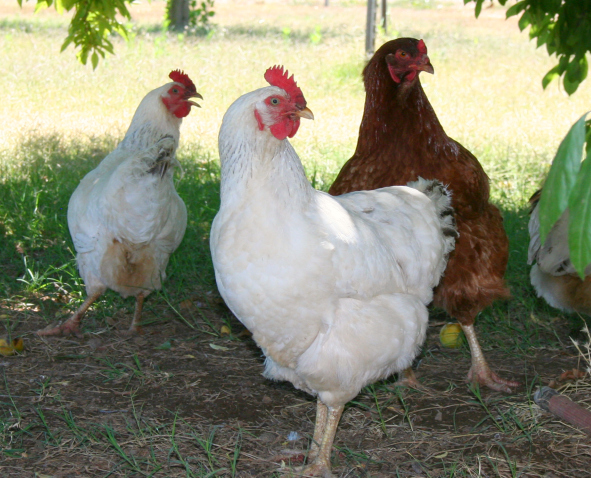
So by now you may be wondering….
What breeds do WE use?
We have a variety of heritage chicken breeds in our yard these days, but my absolute favorites remain the first two breeds we hatched: Buckeyes and Delawares.
Buckeyes are a threatened, dual purpose breed. Ours seem to lay about every other day. Our Buckeye rooster was possibly the most beautiful chicken I have ever seen. Buckeyes are extremely friendly and we hand raised these chicks. Our remaining rooster became conflicted between protecting his hens and wanting to be near us. It’s your standard ‘he attacked us one too many times’ story, which was incredibly sad. But we just don’t have the room to keep a rooster…yet. This rooster grew to be 2 feet high, with thumbs the size of a small knife, and tail plumes that were absolutely beautiful. He was a year and a half old when we butchered him and he graciously gave us 11 pounds of grain free meat. One chicken. Seriously.
Delaware chickens have a fascinating history which is what won me over. They are actually the original grocery store roaster that was replaced in the 50’s by the Cornish Cross. After that they became critically endangered and are on their way back thanks to breeders such as Kim Consol of Star Rose Ranch. Our Delawares are great layers for a dual purpose bird, and even lay well during the winter. They are also extremely friendly and vocal, following us around the yard and talking at the same time.
For a peek at our Buckeyes and Delawares you can take a look at the pictures above. Maybe after we finish raising our new batch of super cute Salmon Faverolles I will change my mind. But I think these two breeds will be our primary choice from now on.
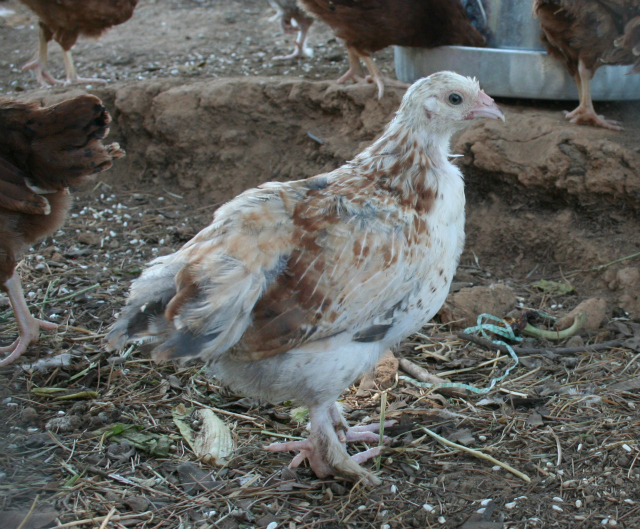
In addition to Delawares and Buckeyes, our laying hens include Dominiques, Astrolorps, and Wyandottes. It will soon also include Faverolles. You can check the American Livestock Breeds Conservancy List for more breed information.
And for more information on chickens and further research, check out these sources:
Harvey Ussery: here and here
Backyard Chickens
Organic Chickens
(I would recommend avoiding the Storey’s Guide to Chickens. That was a complete waste of money for me. Sorry, Storey Publishing.)
Coming soon! What to feed your allergy safe chickens.
Hope is contagious. Pass it on!
~ Nichole
This is a very interesting topic. I have my questions tho… Where do you live? Here in the north land, when we have no forage for 4 to 6 months out of the year, what do we feed? I have a large flock, and love that they just forswitzerland summer, with supplemental veggies and scraps spring and fall, but winter is long and hard and we feed grain. Ideas? I cannot afford to just feed them meal worms, lol! They don’t eat hay.
We are in Northern California. The summer is actually the most difficult due to the heat and lack of vegetation in the field. Next post will be on feed ideas, but in the meantime, what type of birds to you have? Do you have the option of growing worms? And they may not eat hay but they should eat alfalfa.
I’m in NorCal, too! I have a mix of heritage breeds, home hybrids, and sex links. I think I’ll stick with heritage breeds in the future, but I’ve actually had a good experience with the sex links so far. I love my Delaware hen, Della, but I haven’t tried Buckeyes or Faverolles yet. Love our Barred Rocks, and my point-of lay pullets are Speckled Sussex and Buff Rocks. We have about 15 breeds total and there are several I wouldn’t buy again. I will try to get breeder stock in the future. Our one Buff Orpington is my orneriest hen, and they’re supposed to be sweet and people-friendly. Oh well.
I have found that all my hens, of any breed, love free-ranging and get a lot of their diet that way. I supplement with soy-free certified organic layer pellets from Modesto Milling. I also sprout seeds for them.
I also love Harvey Ussery.
By all means, get the Harvey Ussery book that Nichole links. He does a great job talking about different sources of food for your birds and how to supplement through the winter. He lives in Northern VA, so while he doesn’t experience the most severe of winters, he does need to supplement through the winter months. He does use grain, but his goal is to eventually source all of his feed locally, and he wants to provide as much as possible from his own 3 acres, so he talks a lot about feed sources that may seem surprising at first. The thing is, chickens really didn’t start eating much grain until the early 20th century with the advent of industrial agriculture, and they certainly didn’t exist solely on bagged feed. Commercial feed preparation were necessary to fuel industrial chicken farms. Historically people let their chickens graze & gave them chicken scraps. Grain, if used at all, was reserved for winter as a supplement. In the past people learned through trial and error what was best to feed their birds. If the birds stopped laying or started losing weight, then they tried something else. It does take some time and effort, but don’t be afraid to experiment. 🙂
Excellent article, Nichole! We had to leave our flock when we moved from Virginia to Alabama and we just got our new flock established within the last week. This information is very helpful!
Thank you Stephanie! Enjoy your new birds. 🙂
Great info! I need to get different birds! mine eat way too much and we are trying to get them off of the “crap” feed. Feeding them sprouted seeds and its just not cost effective.
We’ve gone the organic route. We love our Wyondott’s the best. They are great layers and produce chicks. I also like our Aracauna’s. Although not as prolific layers they have great personalities and are hearty for MN winters.
Can you please post what you DO feed your chooks. I’m going to assume things such as soldier fly larvae, red worms and food scraps. Unless you have managed to make a good grain-free pellet, I am unable to think of anything else.
Cheers,
Luke.
Yes! Check the link below. I just added a post on this. 🙂
Hey, we’re practically neighbors!! 🙂
My husband and I are in Modesto, and boy do we know about dealing with Big Ag…he’s actually a farmer, but also has a Masters in Ecology and Sustainability with an emphasis in Permaculture.
I have an autoimmune disease and after several years of struggling with it, with pretty much no help from doctors (except a pill, of course, with a dosage that consistently needed to be increased, and no explanation of why that was), I discovered Auto Immune Paleo/Protocol (AIP) and it has worked WONDERS in the last 10 months that I’ve been following it- and I LOVE to hear about the success you’ve had with your little one and her healing diet!! God bless the wonderful women (and men!) who have gone before us to provide us with truly life-saving knowledge!!
Anyway, with the high cost of high quality food, especially meats and eggs and organic produce, my husband’s and my passions combined to form our little suburban homestead- it is little indeed, and we’ve only just started….which brings me to my question!
Is there anything in particular you did with baby chicks?
We just got our first 6 chicks a couple weeks ago, but within 5 days, they were all dead 🙁
We got 6 more, and they’ve been doing great for just over a week but it’s become clear in the last 24 hours that one of them will die soon. It is the runt of the brood, but this was exactly how it started last time. Both times we got 2 Rhode Island Reds (though the second time, it was Production Reds since they were out of the normal heritage reds), 2 Black Laced Wyandottes, and 2 White Brahmas, and both times the runt was a White Brahma.
Symptoms are droopy/sleepy eyes, lethargy/listlessness (not even really trying for food unless it’s mealworms), semi-paralysis (mostly in legs), and just sleeping more and more until they can’t get up even when they try.
After the first round of chicks, I figured they were just not getting enough food with the chicken scraps I gave them (they were all raw- carrots, radish, cabbage, and lots of greens), so I started the new batch with almond meal, shredded unsweetened coconut, and flax seeds, and some greens. Plus we’ve been supplementing with mealworms.
When the White Brahma (Sheila) started looking a little listless yesterday, I got a little concerned about carbs (they’re only a couple weeks old so we were focused more on protein), so I tried giving them some roasted acorn squash and they weren’t very interested in it, though they did pick a little at the seeds (which I chopped up raw in my Ninja).
Anyway, I’m a city girl, lol, and it’s just a little heartbreaking every time another little chickie dies, so I thought I’d reach out and see if you could share any wisdom specifically for baby chicks. Maybe I can’t save Sheila, but I would really like to try to save the others! Anything would help! Thanks in advance, and can’t wait to keep up with your journey as we continue in ours!!
Hi Nichole,
Where do you find heritage breed chickens to purchase for laying eggs? THANKS!
Hi Chelsea
I sourced local connections for breeders nearby.